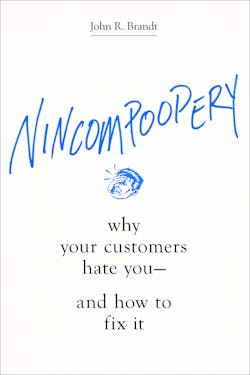The following is an excerpt from a new book by former IndustryWeek Editor-in-Chief John R. Brandt: Nincompoopery: Why Your Customers Hate You — and How to Fix It (HarperCollins, 2019).
Connectivity and the resulting relationship economy have changed the way customers think about value. It’s no accident that smartphones—which leverage wireless communication, access to the internet, and social media to connect us 24/7—have spread faster than almost any technology in history. The original telephone needed 50 years to move from 5% to 50% reach into U.S. households; smartphones went from 5% to 40% in four years—during the worst economic downturn in seventy years. Yet despite all the jokes, hand-wringing, and kvetching about how smartphones have made society and our personal lives worse—Thanksgiving dinners full of people posting grudges on tiny blue screens in their laps instead of arguing face-to-face—we love being connected with the larger world and in particular with each other. The anxiety that we as individuals sometimes feel about how technology is changing our personal relationships reflects a broader societal uncertainty about the new rules of acceptable behavior in a digital environment. What are the rules of attraction and interaction when we connect primarily via text and chat and finger swipes?
But at least we’re thinking about how our personal relationships might evolve in a digital environment. At work, we’ve barely considered how these new technologies are altering our professional lives. That’s a mistake, because the blizzard of connectivity we enjoy and endure each day profoundly impacts business culture, too, and changes how we manage our organizations, our careers, and our personal productivity.These changes, in turn, are fundamentally transforming what customers want from us, and how they want innovative value to be delivered.
How Customers Manage Determines How (and Why) They Buy
To better understand customers today, let’s walk back in time, into the dim mists of ancient personal productivity management (the early 1990s). Before the Apple Newton (1993) or PalmPilot (1997), before the email-enabled BlackBerry 850 (1999) or the iPhone (2007), early humankind relied upon perhaps the greatest organizational invention in history: the Legal Pad Method of Management. Using this simple technique—jotting down every single task you could ever imagine doing if you had unlimited time, money, and bandwidth—cubicle-dwellers and CEOs alike could create lengthy, anxiety-producing lists that promised two things:
1. You could see, with absolute clarity, on a single sheet (or pad) of legal paper, all the obligations you’d successfully ignored for days, weeks, or months.
2. You could understand, with soul-crushing finality, the absolute impossibility of ever completing even a tiny fraction of the to-dos on your list.
But there was hope. Because if you were truly well-versed in the Legal Pad Method of Management you could, once a week or once a month, accidentally or on purpose, lose the entire list.
Why does this matter? Because, under official Legal Pad rules, when you re-created a lost list, everything you didn’t want to do magically vanished, as if the universe itself had granted forgiveness for all your past incompetence, procrastination, and laziness.
It was magnificent.
Today, however, we are beset by personal productivity technologies that never forget and are backed up in the cloud. This means that every morning, when we look into our smartphones or computers, we are immediately confronted by a tidal wave of overdue tasks, weeks-old emails, and unanswered texts that prove, beyond a reasonable doubt, what a loser each of us is—and how much each of us will never achieve in the future, because we can’t even manage ourselves today.
It’s a disaster.
The only consolation, such as it is, is that we are not alone. All of our peers and, more importantly for our purposes here, all of our customers and clients feel exactly the same way.
The impact of this change on how customers perceive value and what they ultimately buy is dramatic. In a business culture driven by electronic to-do lists that never go away, customers feel ever more stressed, harried, and short of time, at home and work. This is bad news for those of us who are marketers and sales representatives; when we seek to offer new products or services to distracted customers, they resist—some actively, some passively—learning about them because learning itself is just another task at the bottom of a list that’s already too long. In fact, when we use traditional sales techniques—describing features and benefits, using open and closed probes—we think that customers are listening, but they’ve probably mentally left the building. Or, even worse, their blank stares mean that they can no longer see us, because in their eyes our heads have morphed into giant smartphones. These customers stare mutely at our enormous blue-screen faces and ask themselves: Is this person trying to add a task, or multiple tasks, to my to-do list? Or is this person offering to remove several tasks from my terrifying to-do list?
This is critical. In industry after industry, customers are turning to companies that focus on innovation through a simple lens: How can we make our customers’ lives simpler, happier, less stressed, and more productive, by removing or solving multiple issues with a single solution? I learned this years ago from a friend who owns an advertising agency; he said that the secret behind all great marketing for professional services firms could be compressed into five words: Me smart, make you rich.
The secret to modern customer value requires six words: Me smart, make you less stressed.
Innovation Isn’t Always What or Where You Think It Is
The wonderful, problematic, maddening, and exciting thing about innovation is how vastly different it is today than just a decade ago, based on how broadly customers now define value. It’s imperative that we think creatively about what our customers really want from us, because it’s often not what we imagine.
JD.com (formerly 360buy.com), an online retailer in China, offers an interesting example of how to rethink customer value. Imagine if during the downturn in 2007 and 2008—the period during which electronics retailer Circuit City entered its high-inventory, low-margin death spiral—you had been offered a chance to invest in an upstart electronics retailer. Would you have said yes? Most rational investors wouldn’t. Yet 360buy.com moved aggressively into electronics retailing just before the global recession and kept going, achieving tremendous growth by rethinking customer value. How? By closing its stores and going online, but with a twist: a completely new take on service and delivery. Customers in major cities served by 360buy.com could now order televisions, stereo systems, or computers online by 11:00 a.m. and have the equipment delivered and installed by 6:00 p.m. the same day. If a customer missed the 11:00 a.m. deadline but ordered by 11:00 p.m., the equipment would be installed and delivered by 9:00 a.m. the next morning. And then, if a customer wasn’t completely satisfied, 360buy.com promised that a representative would return within one hundred minutes to rectify the situation.
Did it work? You judge: 360buy.com’s online revenues grew from $12 million in 2005 to $18.2 billion (as JD.com) in 2013.
These numbers are more than just a miracle of management and logistics; they’re also the direct result of a fundamental shift in understanding what customers value. Leaders at 360buy.com realized that people don’t really want to purchase a television or a sound system or a computer; what they really desire is to watch television or listen to music or surf the web. And they want to do so right now, with as little trouble and inconvenience as possible. Executives at 360buy.com flipped the retail model on its head, moving their sales focus away from products and toward stress-free delivery and enjoyment of those products.
An even more complex case study of value migration is Guinness. The company has grown dramatically in Ireland and around the globe since Sir Arthur Guinness founded the brewery in 1759, famously signing a nine thousand-year lease for forty-five Irish pounds a year. The brand’s longevity (260 years and counting) is due to not only Extra Stout’s unique black color and taste but also to innovative marketing—from memorable taglines (1929’s “Guinness is good for you”) to creative promotions (1954’s launch of The Guinness Book of Records) to clever circumventions of alcohol advertising restrictions (1983’s “Guinness isn’t good for you” campaign). Yet despite worldwide expansion, Guinness’s growth slowed in the firm’s home market of Ireland in the late 1990s, actually declining by 3% in the second half of 2001.
Why? An MBA would start with standard questions:
Has quality declined? Unlikely: Guinness was (and is) still using the same recipe, in the same brewery, that customers have loved for more than two centuries.
Is the marketing budget not big enough? Again, unlikely: As anyone who’s been to Ireland could tell you, it’s hard to turn around on the Emerald Isle without seeing a sign or advertisement encouraging you to drink Guinness.
In many ways, Guinness is beloved in its home market and emblematic of Irish culture. But if the beer is beloved, and marketing is doing all it can, what could possibly cause a slip in sales?
Guinness executives worried. What they found was this: they had a relationship issue. Not with each other or with their partners, of course, but with younger consumers. To twenty-year-olds, Guinness was the brand of old folks. These less experienced drinkers gravitated toward lighter beers (Heineken) or cocktails.
At the same time, others felt that Guinness had forgotten its roots in Ireland; Murphy’s Irish Stout, for instance, commissioned market research that found that while stout (the beverage) inspired images of local pubs and community—bringing family and friends together—Guinness advertising had positioned its own Extra Stout as a “graduation” beer for those with sophisticated palates. Murphy’s launched a campaign to exploit this difference and ended up boosting sales nearly 2%.
Guinness executives got the message: focus on developing a relationship with younger consumers, yes, but understand, too, that the brand doesn’t stand for “stout,” it stands for “community.” That’s hard enough, but how can a company effectively respond to a relationship issue? By increasing the advertising noise on an island already soaked in Guinness black and gold? (Hint: Relationship issues, whether business or personal, are generally easier to solve with less noise, rather than more.)
Guinness chose a quieter path, seeking to transform the brand’s relationship with younger drinkers in unconventional ways. The most visible part of this commitment was the creation of Guinness Storehouse in 2000, a renovation of part of the St. James’s Gate Brewery. The Storehouse includes restaurants, bars, an art gallery, and spaces for meetings or events, as well as exhibits about how Guinness is made. (The coolest feature, though, is an atrium shaped like a pint glass; at the top, the circular Gravity Bar glows at night like the head on a well-poured Guinness.) Most importantly, Guinness made the Storehouse a must-visit destination by scheduling concerts, gallery openings, fashion shows, and private corporate events—as well as all Guinness employee and bartender training—to attract their target demographic audience.
“Over the last twenty years,” said Grainne Wafer, Guinness’s global strategy and communications director, “we’ve been actively looking to the future and thinking about how we bring in the next generation of Guinness drinkers. There is a maturity to the people who come into Guinness, we do find that people tend to come into the brand in their mid-twenties. That’s the area we focus on—guys and girls who are at their first job stage, who are progressing a bit more.”
The most fascinating aspect of the Guinness case study is that the company faced a problem that could not be solved by any of the traditional ways that MBAs are taught to consider. Only by doing deep research, and even deeper thinking, could the company’s leaders understand the difference between what customers were really buying from Guinness (a sense of community) versus how they paid Guinness (for beer).
This is the key question for all of us who manage lines or departments or firms of any size: What do our customers really want from us?
That’s where value now resides, no matter how we get paid for it.
John R. Brandt is the founder and CEO of The MPI Group, a global management research firm, and the former editor-in-chief and publisher of IndustryWeek, where his award-winning column appeared for 13 years. Nincompoopery is his first book.
About the Author

John R. Brandt
Author and CEO, MPI Group
An experienced executive, entrepreneur, journalist, author, and researcher, John R. Brandt is the founder and CEO of The MPI Group, a global management research firm, and the former editor-in-chief and, later, publisher of IndustryWeek in the 1990s and early 2000s.
His book Nincompoopery: Why Your Customers Hate You—and How to Fix It (HarperCollins, 2019)—is based on groundbreaking research into leadership and performance excellence across more than 50,000 organizations. Brandt has earned more than 20 editorial awards for excellence, and also led more than 300 advisory, marketing, research, and data engagements for clients, including Ernst & Young, Deloitte, Grant Thornton, Infor, the Italian Trade Commission, Microsoft, Performance Solutions by Milliken, SAP and many others. Brandt also maintains a busy lecture schedule, speaking worldwide on how organizations, industries, and communities can avoid "nincompoopery and despair" by adapting themselves to the realities of new markets, new corporate structures and new customer expectations.

